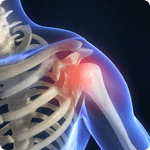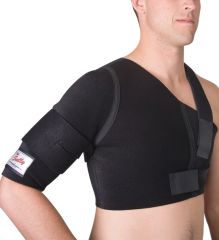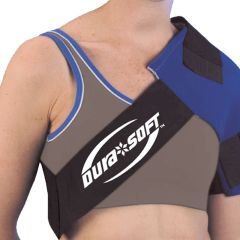Shoulder Arthritis

There are two major joints in the shoulder. The AC joint (acromioclavicular joint) is located where your shoulder meets your collarbone. The glenohumeral joint is where the upper arm bone meets with your shoulder blade. Both of these joints can be affected by arthritis. The three major types of arthritis that affects the shoulder are osteoarthritis, rheumatoid arthritis, and posttraumatic arthritis.
Causes of Shoulder Arthritis
The cause of shoulder arthritis depends on the type of arthritis you are affected by. Osteoarthritis of the shoulder is typically a result of old age. It most commonly affects the AC joint rather than the glenohumeral joint. Rheumatoid arthritis is caused by an inflammation in the joint lining. It can affect patients of any age and usually affects both shoulders. As its name suggests, posttraumatic arthritis is caused after an injury, such as a broken shoulder bone or shoulder dislocation. It can also occur after a rotator cuff tear.
Symptoms of Shoulder Arthritis
The most common symptom of shoulder arthritis is pain that worsens during activity. This pain may also increase with changes in the weather. The pain can be centered in the back of the shoulder (glenohumeral) or in the front of the shoulder (AC joint). Some patients may also experience limited mobility or have difficulty lifting their arms. Pain can also cause difficulty sleeping at night. Other symptoms include swelling, stiffness, and a feeling of grinding around the joints.
In order to diagnose shoulder arthritis, your doctor will take note of your medical history and do a physical examination. Certain tests may be used to help in the diagnosis, such as X-rays, MRIs or blood tests.
How to Treat Shoulder Arthritis
As with any injury, your doctor will be the best source of advice on the appropriate treatment method for your situation. Treatment may also vary depending on the type of shoulder arthritis you have. Rehabilitation typically starts by resting the shoulder and avoiding the types of activities that cause pain. You may even need to change the ways you move your arm to avoid aggravating your shoulder. If you're experiencing pain, you can also take anti-inflammatory medications such as ibuprofen and aspirin, and ice your shoulder a few times a day for 20 to 30 minutes.
Note: The Aircast Shoulder Cryo/Cuff with Cooler provides cold therapy and compression to help minimize the pain from shoulder arthritis.
Your doctor may also recommend physical therapy. Your therapist will show you exercises to strengthen and stretch the muscles and to increase your range of motion. This can help better support your joint and reduce your arthritis symptoms. In some patients, steroid injections can be used to decrease inflammation and pain within the joint.
In cases where conservative methods do not reduce pain, your physician may recommend surgical options. This can range from shoulder arthroscopy or to partial or full shoulder replacements. Surgical treatments for shoulder arthritis are generally very successful in reducing pain and increasing range of motion.
Support and Protection for Shoulder Arthritis
View All Braces for Shoulder Arthritis








